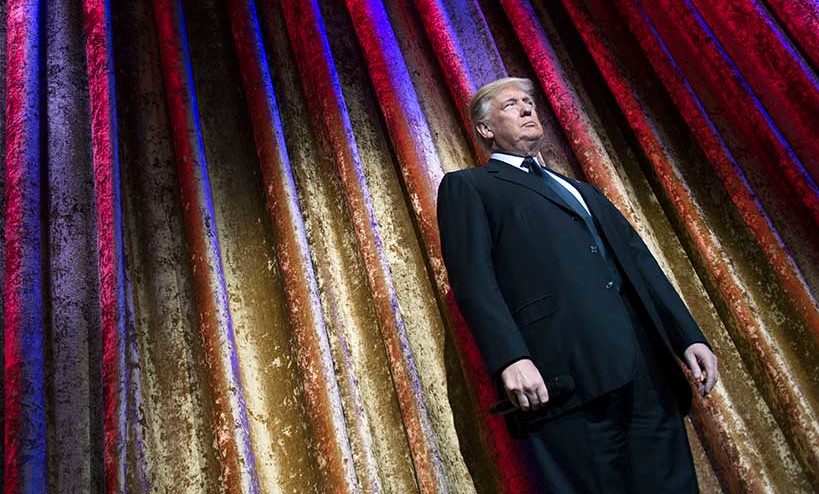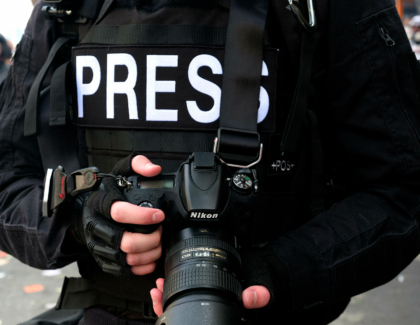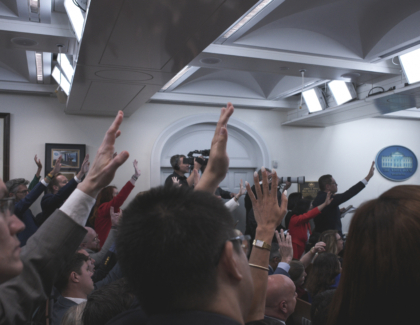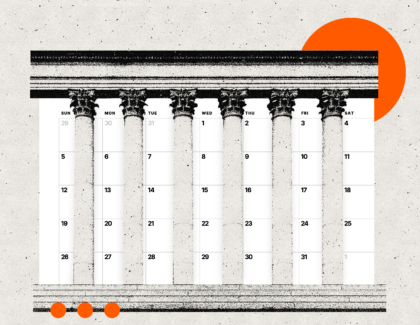Sign up for the daily CJR newsletter.
Since the election I have heard a network anchor and a Times correspondent speak independently of an ongoing “soul-searching” process at their organizations and give exactly the same examples of what the media “got wrong.” Two things: (1) overestimating the polls and (2) neglecting the angry white working class out there in a rusty heartland that might as well exist on the moon for most American news organizations. As for the polls, when all the ballots are finally counted, they will turn out to have been pretty accurate on the national scale–in a nation where decisive power is held by the states. As for neglecting the white working class, no kidding, but what else is new? Neglect of large swathes of the population is normal and will become all the more so as small newspapers dwindle.
Trivial reforms may be in the works. More skepticism can be expected, and less obsequiousness. But will the better angels of our media face up to their moral and philosophical crisis? Will they understand how Trump blew a hole in the already shaky rituals–especially he said-she said equivalency–which they fancied would serve as guarantors of objectivity? Which among them will understand that to claim respect for truth they must be unabashedly oppositional, and cease the kabuki game of taking systemic liars and fantasists in high places at their word? Will they go deep and face up to the multiple ways they put Donald Trump on the map and kept him there over the decades?
To date, Trump has proved himself a growth machine, not a self-destroying one. His brand is the ultimate triumph of a culture that worships conspicuous consumption and raw power. He is less master builder than master borrower, master marketer, and master exploiter of government largesse. The only gospel in play is the prosperity gospel. Under its sign, he and the image industry have been joined at the hip, flattering the rubes, dwelling in an impunity they share while paying lip service to archaic virtue. Making up rules and breaking them as he pleases, Trump is the fit embodiment of an age when disruption is a high calling. Trashing social duty as a game for losers is American holy writ. Call the spirit of the age by its proper name, suckers: nihilism.
‘The great dumb media chamber of the absurd’
Donald Trump doesn’t fit the popular stereotype of a Baby Boomer–long hair cascading down, peace sign bumper-sticker, water pipe–but a Baby Boomer is exactly what he is. Born in 1946, two months before Bill Clinton, Trump (along with age-mate George W. Bush) represents the retro branch of his cohort, the fast-living, high-consumption swinger whose swaggering 50s never ended and whose idea of the good life was patterned on Hugh Hefner’s. Hef’s beau idée (as he wrote when Trump was still in short pants) was a bachelor life devoted to moments when the lucky guy would find himself “mixing up cocktails and an hors d’oeuvre or two, putting a little mood music on the phonograph”and engaging a woman with “a quiet discussion on Picasso, Nietzsche, jazz, sex.” Quiet conversation was not Trump’s style, nor was Cubism, but buxom models were, and real estate, and lavish full-color displays of a meat-market dream in which women were the pleasure-giving ornaments. Eventually, at a Playboy mansion party to which he escorted “Apprentice” figures years later, Trump told Hefner: “It’s hard for me to tell which of these girls are yours, and which ones are mine.”
Hef made dirty look clean; there was always something old-school and air-brushed about him, down to his traditional pipe, his smoking jackets, and his mansion. Trump got a head start, growing up in his father’s mansion, though in the unfashionable borough of Queens. To make his gilded mark in Manhattan he had to build on Fifth Avenue and brag about his conquests in the tabloids. He reveled in smirking. Long before the Reagan era, when Dallas, Dynasty, and Lifestyles of the Rich and Famous would glitz up the screen with ever-gaudier images, Trump recognized that the spectacle of a glittering devil-may-care ascent, suitably airbrushed, was eye candy for wannabes indulging their fantasies of finding themselves ensconced in his penthouse.
His game was: What would he get away with next? Even as other businessmen found him disreputable and bankers learned to avoid him, he turned himself into a walking promo for a way of life to die for. Media anointed him as worthy of rapt attention, and he returned the favor even when he had to pay for it, as in 1989, when as a sort of bloodthirsty ambulance chaser, he bought full-page ads in the New York dailies to call for the death penalty after five dark-skinned teenagers were arrested in a brutal Central Park rape to which they had confessed falsely, under duress. (When the actual rapist was nailed with DNA evidence, and the young men, no longer teenagers, were exonerated after serving years in prison, Trump hammered on about their guilt.) Whatever. The media don’t know how to shun; they glow. Once Trump’s name was huge enough, he could slap it onto towers whether he owned them or, increasingly, did not. Trump, the star of his own life, reemerged again and again as the man whose brand was his product.
Trump recognized that the spectacle of a glittering devil-may-care ascent, suitably airbrushed, was eye candy for wannabes indulging their fantasies of finding themselves ensconced in his penthouse.
In so many ways, Trump craved the spotlight, thrived on it, and it adored him throughout the mini-dramas of his crashing and burning and resurrection, because the great dumb media chamber of the absurd thirsts for light from stars whether dying or being reborn. He got the game, telling an early biographer, Michael D’Antonio: “I never had a failure, because I always turned a failure into a success.” In the words of his piercing chronicler Wayne Barrett, when Trump left his first wife, Ivana, for the woman who would become his second, Marla, “Trump told Newsweek the scandal was ‘great for business,’ and pushed Marla to seize on the opportunities it presented, including half a million to pose in ‘No Excuses’ jeans.” Thus did he parlay a failed marriage into a great career move and watch bankruptcies morph into reinventions. The lust was reciprocal. He was adored by millions who hungered for the thrill of his incandescence, finding in the spectacle a sybaritic version of their thwarted self-affirmation, cheered on by an audience bedazzled: Get a load of this! By the only criterion a nihilist media knew, he was a winner. He was Gatsby trailing a Daisy chain.
We would not know the name Donald Trump, there would be no Trump campaign, no platform for his political takeoff, no world stage for him to strut on, not even name recognition, had the man not succeeded in casting himself as the eventful, endlessly re-invented incarnation of over-the-topness, an avatar for losers, an amusing magnet for envy, a non-stop performance piece in which, through every medium in sight, his shameless gaudiness collected eyeballs and eardrums by the millions.
‘The love of power married the love of lies’
So it is that Trump’s attention-getting career in self-inflation, bravado, and impunity is now well into its fourth decade with no end in sight–from midtown Manhattan real estate into the New York tabloids, through best-selling books that he did not write, through his profitless airline, to his branded hotels and casinos, through talk radio and reality TV, to a ready audience for the birther fraud, to dominance of the dog-and-pony shows called “political debates,” to Twitter barrages, to his escalator glide down into the atrium of his eponymous Tower, delighting in his impunity, swooping to every crevice of a culture enchanted by its own blindness, now forever to be enshrined as a boldface name in an America where that is more significant than being a bald-faced liar.
In Trump, the love of power married the love of lies. Having catapulted to national glory on the strength of surely the most perverse slogan in the history of America–“You’re fired!”–he trained as the people’s bully. With collaborators as avid as America’s culture industry, no wonder he reveled in the assumption that he could get away with anything. His fraudulent and unapologetic utterances only underscored that he was bigger than any rule, more satisfying than reason, more thrilling than sense. All the subterranean resentment in American life erupted in the bursts of his phrasing, freed as it was of logic or evidence, heavy with insult and insinuation. The humdrum sound bites of his rivals he chewed to ribbons. For his fans, his sneers were proof of his “authenticity.” The loathing of his adversaries only reinforced his fans’ resentment.
Media enabled Trump to wrap himself in the funhouse mirror, not least in the cynical concoction known as “reality television,” the latest phase in America’s centuries-long romance with the con artist as denoted by Herman Melville in The Confidence-Man (1857) and personified in the showman P.T. Barnum, who upended truth and tickled the rubes by showing them how he tricked them. (Barnum ended up in politics, and in a show of great irony, his eponymous circus announced last week it was closing down, all but outdone by the real political circus unfolding in the capital.) Lavishing attention on Trump whatever he said or did, the media enabled Trump to build up his deceits and dance away from responsibility by appearing to be no more than a showman. Trump did not invent American disbelief: sarcasm, misleadingly known as “irony,” has become our prime comic mode. But only Trump has shown how much power lies in the convergence of post-truth, the will to believe, and vicious belligerence.
The strut, the arranged hair, the practiced jut of the jaw–these character points might be funny if they were not so eerie. But however different the past is from the present, we keep having to remind ourselves of the difference because we have seen, or heard of, this movie before; at least we have seen the trailers. When leaders toy with the forms of democracy to rain contempt on its institutions, when propaganda networks on TV and radio marry broadcast fraud to keyboard blasts, the dictators of the last century come to mind. Such forebodings should not be dispelled too quickly. Our own media are not done devising inventive patterns for weird mixtures and vicious circles of cynicism and gullibility. Hannah Arendt’s insight into the mentality of totalitarianism remains timely:
The whole hierarchical structure of totalitarian movements, from naïve fellow-travelers to party members, elite formations, the intimate circle around the Leader, and the Leader himself, could be described in terms of a curiously varying mixture of gullibility and cynicism with which each member, depending on his rank and standing in the movement, is expected to react to the changing lying statements of the leaders and the central unchanging ideological fiction of the movement.
So much for a sketch of the Trump brand. Let us now more slowly review its phases.
• Tabloids. Through the ‘80s, as Trump acquired buildings and women, and even more important, the reputation for them, New York’s tabloids adored him. New York is the only city in America to boast two daily tabloids–the Murdoch-owned Post and the sort of centrist Daily News. Trump cultivated them like his personal flower boxes. He planted stories. He chatted up reporters, sometimes disguising his voice and pretending to be his own PR man. He would phone the News’ gossip columnist “to brag about the model he had been with the night before or get into some silly spat and leak an angry letter.” Trump even piped a purported quote from Marla Maples onto the front page of the New York Post: “Best Sex I’ve Ever Had”–preceded, in smaller type, by: “Marla boasts to her pals about Donald.” Lou Colasuonno, the News’ top editor in 1992-93, when Trump’s marriage to Ivana was crashing and burning, said Trump was “like a walking, talking tabloid editor’s dream. He was fun. He was entertaining. He sold papers for us–no question.” One former News reporter told Politico:
He was this guy who walked out of tabloid heaven. He was rich. He was vulgar. He was a city guy … and the women–business, sex and a guy who loves the attention. You couldn’t beat it.
From this platform, Trump became national catnip. Tabloid pieces about his showy exploits made their way into the bigger-league press too. For a new Gilded Age, his was the exemplary success.
• Bestsellers. In 1987, Trump was able to parlay his sculpted reputation into The Art of the Deal, topping The New York Times’ best-seller list for 13 weeks, running up 48 weeks total on the list, and selling something like a million copies. As is routine for celebrity books, this one was ghostwritten–by the magazine writer Tony Schwartz, who much, much later confessed to the New Yorker’s Jane Mayer: “I put lipstick on a pig. I feel a deep sense of remorse that I contributed to presenting Trump in a way that brought him wider attention and made him more appealing than he is.” If he were writing The Art of the Deal today, Schwartz said, he would call it: “The Sociopath.” Their partnership began when Schwartz sniped at Trump in New York magazine. Trump wrote him a fan letter. “He was obsessed with publicity,” Schwartz said, “and he didn’t care what you wrote.” Trump’s self-boosting franchise spurred a series of lesser bestsellers, and Schwartz got to upgrade his standard of living.
• Howard Stern. In the ‘90s, deep in financial trouble from foolish casino investments, Trump enlarged his brand by stepping up as a supporting character for talk radio’s top dirty-talking loudmouth. His role: to suck up humiliations. It was a match made in locker-room hell.
• Reality TV. Trump was poised for household glory. In a sense, his entire career already consisted of episodes in a reality show–performances of the winner “Donald Trump,” passing out “successes” that lesser beings could scramble for. Now that old-style network television was floundering, opportunity knocked. NBC Entertainment’s chief, a master showman named Jeff Zucker, had an eye for down-market success at a time of shrinking network audiences. As educated viewers were peeling away to the galaxy of cable offerings, the big networks could compensate with grosser offerings. Zucker had already scored a ratings success with the stunt show The Fear Factor. Reality shows, cheap substitutes for scripted series, were taking off, in particular Survivor, produced by the British impresario Mark Burnett. Burnett and Zucker spotted the commercial potential of Trump’s swagger. Burnett, like Trump, cottoned to Social Darwinist fantasies in which losers get disposed of by the forces of nature. The president of NBC Entertainment, having accrued big numbers with Fear Factor, a “reality” successor to Survivor, signed up Burnett and Trump, with Trump playing himself. In 2004, The Apprentice averaged 21 million viewers per week. There followed, less lucratively, Celebrity Apprentice. Trump was now, legitimately, huge.
• The birther junket. Because Trump was now a household name, his embrace of the fraudulent, meant-to-be-derogatory claim that Barack Obama was Kenya-born made news, and won over fans who could not accept that a black man had been elected president of the United States. By now, whatever Trump said was–by corrupted definition–newsworthy. The so-called birther movement had been spawned in 2008 by a litigious Southern California dentist named Orly Taitz. By 2009, even Bill O’Reilly was calling her “a nut.” The birther movement found itself leaderless. Trump, one of the greatest opportunists in the history of America, seized the opportunity to lead the crazy parade. Whether he grasped that this was a sure route to the hearts of hard and soft white supremacists is anybody’s guess. Odds are, he intuited that the delusional Obama-haters were a base for a racist wave he could ride.
• The campaign itself. Exuberant in their resentment, his crowds were ready to roar, and it didn’t take long for them to find out that it was Trump they were roaring for. Soaked continually in inflammable Hillary-hating, xenophobic propaganda over the course of years–Fox News, talk radio, all that noise–and saturated by Republican-fueled media obsessions with Benghazi and e-mails and the Clinton Foundation and other barely comprehensible proofs that Hillary Clinton was the devil-woman incarnate, they were itching to overthrow the establishments of both parties whom they blamed, not without reason, but rather indiscriminately, for decades of contempt and neglect. The time had come for revenge.
Donald Trump, toxic bullshitter, emerged from a whole zeitgeist of nihilistic attention-grabbing enterprises that we helplessly speak of as “the media,” that unprincipled, slithering, polymorphous process that observes only one logic: the making of fortunes.
As Trump won primaries, his spectacular value snowballed even as he left a trail of falsehoods scattered behind him faster than any fact-checkers could clean up. No one could rival him for newsworthiness. What could be more of a story than boisterousness, nastiness, and nonsense? Once he clinched the nomination, his success was an embarrassment to serious journalists. What would they do? They fretted, but many were trapped inside their codes of good conduct. Their decades of commitment to the bland music of false equivalency gagged them. What gave them the right to call a charlatan a charlatan? Was there an ideal of professional responsibility strong enough to prevail over the dopey routines of he-said-she-said? What was truth worth? What did an emergency for the republic require?
In late May and June of 2016, many honest and decent journalists in mainstream media sat themselves down for some much-needed soul-searching. For months they had dutifully trudged along, applying to a transparent fraud what the sociologist Gaye Tuchman once called the “strategic ritual” of objectivity, yet Trump had not cared a whit when caught out in falsehoods, delusions, and self-contradictions–and most alarmingly, his supporters did not seem to care. Would journalists step out of their bondage and call garbage garbage and falsehoods falsehoods?
Even as Trump was the undisputed front man for the most vicious, bigoted, fact-bare, logic-starved, violence-inciting and otherwise deplorable and demagogic political campaign in memory, even as fact-checkers lost sleep trying to keep up, the zombie of false equivalency stalked the campaign. From mid-July through mid-September, according to Gallup, by far the main association Americans made to Hillary Clinton was–emails. This wasn’t just the consequence of a media barrage; Clinton had policy positions galore but no big story to tell. Still, wading into a vacuum, the media wrapped her in their own big unbeautiful story: emails. She was the email queen–Hillary Email Clinton, successor to Hillary Whitewater Clinton, Hillary Cattle Futures Clinton, Hillary Vince Foster Clinton, Hillary Lesbian Clinton, Hillary Feminazi Clinton. In September, if you were paying close attention, you saw Newsweek’s Nina Burleigh report that George W. Bush’s White House had “lost” 22 million emails, but never mind: For most of the nation’s media, that revelation, along with the revelations that Colin Powell and Condoleezza Rice had both resorted to private servers, was a one-day wonder, lost in the clamor of nonstop accusations against Clinton. Trump was blunt, yes; reckless, yes; ignorant, yes; sexist, yes; vicious, yes; but the sheer scale of his sins could afford no competition for the months-long, day-in, day-out howls that had long since become the media wardrobe wrapped around Hillary Clinton. Benghazi, Benghazi! Emails, emails! As House Committees howled at her heels, was that not news? What did Trump’s use of the Trump Foundation to buy his portraits and pay his businesses’ bills matter in the light of Hillary Clinton doing…something…whatever it was…wrong…criminal…about the Clinton Foundation. False equivalency heaped to the heavens. The impressions stank. The slippery slope had been long prepared for: Lock her up! Hang the bitch!
Meanwhile, starting in July, when Vladimir Putin’s ally Julian Assange began a regular dump of thousands of emails hacked from the Democratic National Committee, most media unreflectively accepted Assange’s premise that an arguably newsworthy thread (the DNC’s marked tilt against Bernie Sanders during the primaries) rendered every shred of the Party apparatus’s private chat equally entitled to public attention. The blue-ribbon press turned themselves into conduits, with Assange as a contributing editor. Wads of raw data churned into the media mainstream, week after week, on Assange’s chosen schedule. Then the products of the John Podesta hack began. Week by week, the association was engraved deeper: Democrats–email–corruption–crooked Hillary–surely there’s a pony in the midst of this stream of ordure! This was propaganda by insinuation: the most insidious kind.
‘The dark arts of bullshit’
What journalism as a whole failed to grasp about Donald Trump goes to a systemic breakdown in the theory of accountability. Tony Schwartz, Trump’s onetime ghostwriter, put his finger on Trump’s imperviousness: “More than anyone else I have ever met, Trump has the ability to convince himself that whatever he is saying at any given moment is true, or sort of true, or at least ought to be true.”
In other words, Trump perfected the dark arts of bullshit. But he did not invent them. Truthiness, the appearance of plausibility, was already surging through American political culture. In this century alone, propaganda barrages enjoyed two successful trial runs: first, the Weapons of Mass Destruction falsification that George W. Bush deployed as prime rationale for the ruinous Iraq war; and second, the scurrilous Swift Boat Veterans for Truth assault that ground John Kerry’s 2004 campaign to pieces. Falsehood, always a weapon in the arsenal of power, was in the ascendancy. The philosopher Harry Frankfurt spoke with analytical precision to the bullshit phenomenon:
It is impossible for someone to lie unless he thinks he knows the truth. Producing bullshit requires no such conviction. A person who lies is thereby responding to the truth, and he is to that extent respectful of it. When an honest man speaks, he says only what he believes to be true; and for the liar, it is correspondingly indispensable that he considers his statements to be false. For the bullshitter, however, all these bets are off: he is neither on the side of the true nor on the side of the false. His eye is not on the facts at all, as the eyes of the honest man and of the liar are, except insofar as they may be pertinent to his interest in getting away with what he says.
Donald Trump, for once, preferred a more tasteful term: “truthful hyperbole.” In Trump’s voice, Schwartz explained in The Art of the Deal: “I play to people’s fantasies. . . . People want to believe that something is the biggest and the greatest and the most spectacular. I call it truthful hyperbole. It’s an innocent form of exaggeration–and it’s a very effective form of promotion.”
Frankfurt nicely pinpointed a core component of America’s penchant for hype, advertising, showmanship, spectacle, self-promotion, and deception indistinguishable from self-deception. Bullshit is not lying, which, after all, posits that the speaker first knows the truth and then misleads. Bullshit is a performance delivered without regard for truth or falsity. Bullshit paralyzes the critical impulse. It only succeeds insofar as its recipients swallow it, even gleefully–this is the cynicism-gullibility loop that Arendt identified. Everyone plays the great game of bullshit. It requires no tedious visits to logic or evidence. Deniability is everywhere. Everyone is supposed to get the joke. What is called “irony”–really sarcasm–is common currency. If you’re revolted, you’ve failed to get the joke.
To sum up, then: Donald Trump, toxic bullshitter, emerged from a whole zeitgeist of nihilistic attention-grabbing enterprises that we helplessly speak of as “the media,” that unprincipled, slithering, polymorphous process that observes only one logic: the making of fortunes. When this period is recalled by historians, if there are any, the golden epigraph, the quintessence of the state of state-licensed corporate morality, will belong not to Trump himself but to CBS’s Board Chairman, President, and CEO Les Moonves, who spoke in February of the advertising cornucopia spilling down upon the network:
“It may not be good for America, but it’s damn good for CBS,” he said of the presidential race.
Moonves called the campaign for president a “circus” full of “bomb throwing,” and he hopes it continues….
“Man, who would have expected the ride we’re all having right now? … The money’s rolling in and this is fun,” he said.
“I’ve never seen anything like this, and this going to be a very good year for us. Sorry. It’s a terrible thing to say. But, bring it on, Donald. Keep going,” said Moonves.
As hardly anyone knows, the broadcast stations that have always been essential to the prosperity of networks are licensed by the Federal Communications Commission gratis. The airwaves belong–mythically, it would appear–to the public. According to the Federal Communications Act of 1934, they are leased, for fixed terms, to commercial interests on the premise that these operate “in the public interest, convenience, and necessity.”
America agrees to take this imperative as bullshit.
Or does it? There are no doubt unknown unknowns. Devastating scandals may yet be in the works to derail Trump–a delayed game of catch-up. But make no mistake: There’s no quick fix to a crisis as deep as it has been long in the making. The depraved persona of “Trump” who has cast his malignant spell upon the world’s oldest democracy, is a pure product of the American culture industry. He is not only a brand, licensing the use of his name; he has branded America, which has not yet grasped that the joke’s on us. Media have been bearers of his sedan chair, custodians of his image, beneficiaries of his persona for more than three decades now. Shall we hold our breath?
Has America ever needed a media defender more than now? Help us by joining CJR today.







